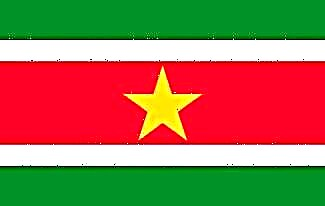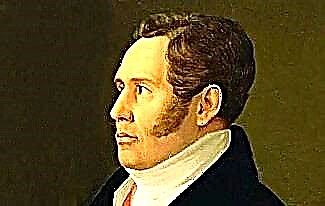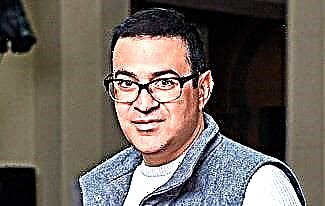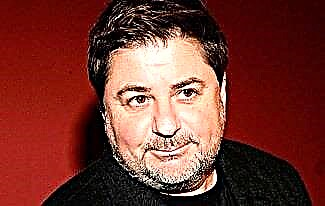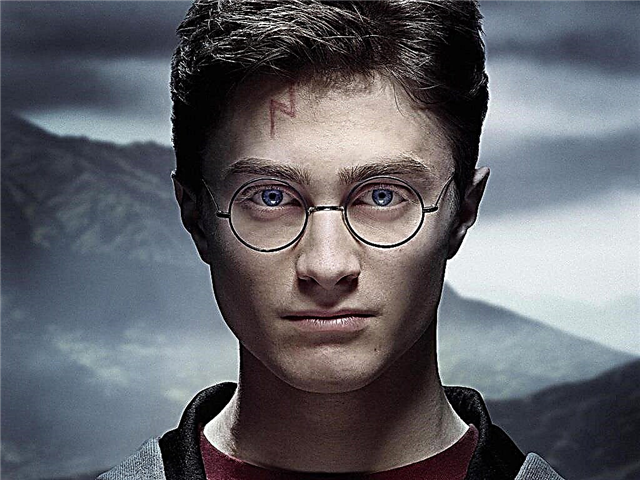Muammar Mohammed Abdel Salam Hamid Abu Menyar al-GaddafiKnown as colonel Gaddafi (1942-2011) - Libyan revolutionary, statesman, military and political leader, publicist, de facto head of Libya in the period 1969-2011.
When Gaddafi resigned from all posts, he began to be referred to as the Brotherly leader and leader of the September 1st Great Revolution of the Socialist People's Libyan Arab Jamahiriya or the Brotherly leader and leader of the revolution.

After his assassination in 2011, an armed struggle for power began in Libya, which led to the actual disintegration of the country into several independent states.
There are many interesting facts in the biography of Gaddafi, which we will discuss in this article.
So, before you is a short biography of Muammar Gaddafi.
Biography of Gaddafi
The exact date of birth of Muammar Gaddafi is unknown. According to some sources, he was born on June 7, 1942, according to others - in 1940, in a Bedouin family near Qasr Abu Hadi, 20 km from the Libyan Sirte. He was the only son of 6 children of his parents.
Childhood and youth
Since Gaddafi was brought up in a family of nomads constantly looking for more fertile lands, he lived in tents. Muammar himself has always emphasized his Bedouin origin, priding himself on the fact that the Bedouins enjoyed freedom and harmony with nature.
As a child, the future politician helped his father graze pets, while his sisters helped his mother oversee the household. Gaddafi changed schools several times, as his family had to lead a nomadic lifestyle.
After classes, the boy went to spend the night at the mosque, so the parents could not afford to rent an apartment for their son. Muammar's father recalled that on weekends, his son returned home, walking about 30 km.
The Gaddafi family pitched tents about 20 km from the sea coast. An interesting fact is that in childhood Muammar never saw the sea, although it was in relative proximity. It is worth noting that he became the only child of his father and mother who received an education.
Revolution
As a young man, Gaddafi was keenly interested in politics, as a result of which he participated in various rallies. He later joined an underground organization that had an anti-monarchist position.
In the fall of 1961, this organization held a rally against the withdrawal of Syria from the United Arab Republic. It is curious that Muammar made a closing speech to the demonstrators. This led to his being expelled from school.
Nevertheless, the young Gaddafi, along with other like-minded people, continued to participate in various political actions, including anti-colonial protests against Italy and support for the revolution in neighboring Algeria.

It is worth noting that Muammar Gaddafi was the leader and organizer of the action in support of the Algerian revolution. The movement turned out to be so serious that it almost immediately grew into a major protest against the monarchy. For this, the guy was arrested, after which he was expelled outside the city.
As a result, Muammar was forced to study at the Misurata Lyceum, which he successfully graduated from in 1963. After that, he studied at a military college, graduating with the rank of lieutenant. In subsequent years, the guy served in the troops, reaching the rank of captain.
It is important to note that Gaddafi trained in Great Britain, where he adhered to all the norms and customs of Islam - he did not drink alcohol and did not visit entertainment establishments.
Preparations for the famous 1969 coup in Libya had begun five years earlier. Muammar founded the anti-government organization OSOYUS (Free Officers Unionist Socialists). The leadership of this movement carefully developed a plan for the upcoming coup.
Finally, on September 1, 1969, Gaddafi, along with a large army of like-minded people, began to overthrow the monarchy in the country. The rebels quickly took control of all important strategic facilities. At the same time, the revolutionaries made sure that all roads to the US bases were closed.
All events taking place in the state were broadcast on the air. As a result, the revolution was successful, as a result of which the monarchy was overthrown. From that moment on, the state received a new name - the Libyan Arab Republic.
About a week after the coup, 27-year-old Muammar Gaddafi was awarded the rank of colonel and appointed head of the country's armed forces. In this rank, he remained until the end of his days.
Governing body
Becoming the de facto leader of Libya, Gaddafi presented 5 fundamental postulates of his policy:
- Expulsion of all foreign bases from Libyan territory.
- Arab unity.
- National unity.
- Positive neutrality.
- Ban on the activities of political parties.
In addition, Colonel Gaddafi carried out a number of important reforms, including changing the calendar. Now, the countdown began from the date of the death of the Prophet Muhammad. The names of the months have also been changed.
All laws began to be based on the principles of Sharia. Thus, the state imposed a ban on the sale of alcoholic beverages and gambling.

In 1971, all foreign banks and oil companies were nationalized in Libya. At the same time, a large-scale purge of oppositionists who opposed the revolution and the current government was carried out. Any ideas that were contrary to the teachings of Islam were suppressed in the state.
Since coming to power, Gaddafi has combined his political views into a concept detailed in his key work - "Green Book". It presented the foundations of the Third World Theory. In the first part, the Jamahiriya was set forth - a form of social structure, different from the monarchy and the republic.
In 1977, the Jamahiriya was declared a new form of government. After all the transformations, new government bodies were created: the Supreme People's Committee, secretariats and bureaus. Muammar was appointed chief secretary.
And although a couple of years later, Gaddafi gave up his post to professional specialists, since that time he was officially called the Leader of the Libyan Revolution.
The man dreamed of uniting Libya with other Arab states, and even agitated Muslim countries to fight against Great Britain and America. He provided military support to Uganda and also sided with Iran in the war with Iraq.
Domestic policy in Libya has undergone significant changes. Fearing a revolution, Gaddafi banned the formation of opposition platforms and any strikes. At the same time, the media were strictly monitored by the government.

Meanwhile, Muammar showed great condescension to dissenters. There is a known case when he got behind the wheel of a bulldozer and destroyed the prison gates with his own hand, releasing about 400 prisoners. Over the years of his political biography, Gaddafi reached noticeable heights in his post:
- Fight against illiteracy - 220 libraries and about fifty educational and cultural institutions were built, which doubled the number of literate citizens.
- Construction of sports centers.
- Construction and provision of dwellings to ordinary citizens, thanks to which 80% of the population were able to get modern apartments.
- The grandiose project “The Great Man-Made River”, also known as “The Eighth Wonder of the World”. A huge pipeline was laid to provide water to the desert regions of Libya.
Yet Muammar's policies have been criticized by many. Under his rule, the country had to endure a conflict with Chad, an aerial bombardment by the US Air Force, during which Gaddafi's adopted daughter died, UN sanctions, for bombing aircraft, and many other problems. However, the biggest tragedy for most Libyans was the assassination of their leader.
Personal life
The first wife of Gaddafi was a school teacher and the daughter of an officer, who bore him a son, Muhammad. Over time, the couple decided to divorce. After that, the man married the medic Safiya Farkash.
In this union, the spouses had six sons and one daughter. In addition, they raised an adopted son and daughter. Over the years of his biography, Muammar wrote several stories, including "City", "Flight to Hell", "Earth" and others.
Death
Before the tragic death of Gaddafi, his life in the period from 1975-1998 was attempted at least 7 times. In late 2010, a civil war broke out in Libya. The people demanded the colonel's resignation, taking to the streets with protests.
On the morning of October 20, 2011, organized detachments attacked the city of Sirte, where they captured Muammar. People surrounded the wounded man, starting to shoot into the sky and directing the muzzle of machine guns at the prisoner. Gaddafi called on the rebels to come to their senses, but no one paid attention to his words.
Muammar Gaddafi died on October 20, 2011 as a result of the lynching of his compatriots. At the time of his death, he was 69 years old. In addition to the ex-head of state, one of his sons was taken prisoner, who was killed under unclear circumstances.
The bodies of both were placed in industrial refrigerators and put on public display in the Misurata mall. The next day, the men were secretly buried in the Libyan desert. Thus ended the 42-year rule of Gaddafi.
Gaddafi Photos









